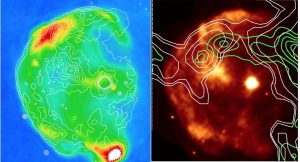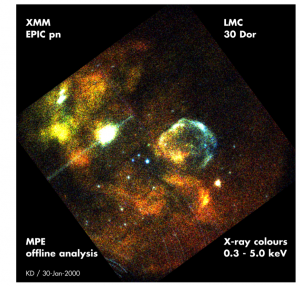Physics of Supernova Remnants and Superbubbles
Stars emit light because they generate energy in thermonuclear burning. Massive stars ionise the ambient medium and inject matter and energy to the ISM through their strong radiation and stellar winds. At the end of the life of a massive star, its core collapses resulting in an explosion called a supernova: a strong shock arises that ejects the outer layers outwards.
A combination of stellar winds of massive stars and one or multiple supernova explosions creates an interstellar structure called superbubbles. Supernova remnants (SNRs) and superbubbles are powered by strong shock waves and emit X-rays from thermal hot thin plasma and from non-thermal processes related to shocks. We study the emission of the shocked interstellar gas, ejecta expelled in supernova explosions, and particles accelerated in the strong interstellar shock waves using multiwavelength data.

SNR CTB109 (Radio continuum of CGPS with XMM-Newton contours, right: XMM-Newton with CO and IR contours). Copyright: M. Sasaki.

XMM-Newton First Light image, showing the LMC superbubble 30 Dor C. Credit: MPE.



